
 |
|
|
Care and Maintenance of the Modern Replica
An article by Patrick Kelly Questions often arise regarding the care of the modern replica sword. Here we will mention a few helpful hints that will assist the owner in caring for, and maintaining, his replica sword. Two things to keep in mind are: "Less is often more" and "It ain't rocket science". Polishing The first topic is that of polishing. First, let me stress that these techniques are strictly for polishing a replica of European type, i.e. made with a homogeneous blade made from one type of steel. Japanese Nihon-to, and their modern equivalents require a very specific type of polishing in order to maintain their aesthetic qualities. Likewise these methods are not suitable for the finish on pattern-welded blades (also known as Damascus steel). 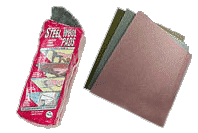 Many replicas, even better ones, will often arrive with scratches or scuffs upon the blades surface that can be a real eye sore to their new owners. Others will often come with roughly machined fullers that mar the sword's aesthetic appeal. These deficiencies can usually be corrected with some patience and a bit of elbow grease. Before polishing can begin the following materials should be obtained:
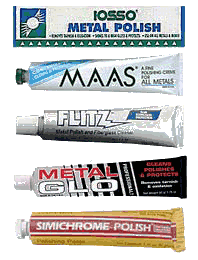 Most of these products can be found at local hardware stores. The fine grit papers can be found at automotive stores or in the automotive section of stores such as Wal-Mart. I have had great success with Gunbrite polish manufactured by Iosso. This can be found in stores; however, the easiest source seems to be Brownells gunsmithing supplies on-line. Another thing that should be stressed is the avoidance of power tools. The heat generated by power tools can harm the blade's heat treatment. The home hobbyist often does not possess the experience with this type of equipment that is necessary in order to achieve the proper sense of control. One slip of the buffing wheel is all it takes to mar that long-awaited sword. Some things can't be rushed, blade polishing is one of these.
Most of these products can be found at local hardware stores. The fine grit papers can be found at automotive stores or in the automotive section of stores such as Wal-Mart. I have had great success with Gunbrite polish manufactured by Iosso. This can be found in stores; however, the easiest source seems to be Brownells gunsmithing supplies on-line. Another thing that should be stressed is the avoidance of power tools. The heat generated by power tools can harm the blade's heat treatment. The home hobbyist often does not possess the experience with this type of equipment that is necessary in order to achieve the proper sense of control. One slip of the buffing wheel is all it takes to mar that long-awaited sword. Some things can't be rushed, blade polishing is one of these.If the newly acquired blade features a fuller which is rougher than desired it should be smoothed out with coarser grit sandpaper or emery cloth. Long smooth strokes will smooth the fuller and remove unsightly grind marks. Care should be taken in order to preserve the sharp outline of the fuller. Using smaller pieces of paper, which fit into the fuller, will prevent the softening of the fuller's outline. Once the fuller has been satisfactorily smoothed, or if it doesn't have one, the main task of polishing can begin. First lay the blade on a flat, solid surface. I usually cover the kitchen counter with a plastic garbage bag and lay the blade across it. A solid non-shifting surface is necessary for stability and control. Start with 1000 grit abrasive paper and sand the blade with firm even strokes, which run the entire length of the blade. You will never be able to eliminate the scratches from the blade's surface. What you're trying to do is even the scratches out and make them increasingly fine through the use of abrasive agents of finer and finer grit. Short, or circular strokes, will not achieve the desired result. As you are making those long even strokes take care of the blade's central ridge. Sand each flat of the blade independently. Don't just lay the paper over the entire surface of the blade and go to town. Doing this will wash out the blade's detail. Like the fuller, you want to preserve the integrity of the flats and ridges, and your sword's appearance. Remember, speed is not of the essence here. Be thorough and have patience and you will be rewarded. Once you are satisfied with the results of the 1000 grit paper you can move up into the 1500 and 2000 grits. Depending on the type of blade and the appearance I wish to achieve I may stop at 1500 grit. This tends to give more of a glossy satin finish rather than a mirror type of finish, which I personally don't care for. As you are working your way through this process remember: WATCH THE EDGE! Blood doesn't make a very good polishing agent. When you have achieved a satisfactory result with the abrasive papers you will then move onto the polishing compound. During this step of the process small short strokes upon the blade's surface are acceptable as long as the final strokes run the length of the blade. No circular motions! Apply an appropriate amount of your chosen polishing compound to the blade and begin rubbing vigorously with the steel wool. Take care of the edge, however, and don't be afraid to rub the beejaysus out of it! The harder you rub the better the compound will do its job. After the blade has reached a pleasing level of finish remove any excess compound by buffing the blade with a soft cloth. At this point the blade should have a nice bright finish on its surface. You may stop here of you choose and the polishing compound will provide protection to the blade. I usually take the process one step further. I remove the remaining compound with a household cleaner such as Windex. I then apply a coat of oil to the blade. This dulls the bright finish down just a bit and the final result will be a very attractive burnished sheen that is very authentic in appearance, and easily maintained as well. Protection 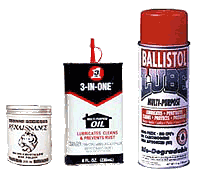 I mentioned oil in that last paragraph didn't I? Well, since I brought it up we might as well discuss it. This is where the "It ain't rocket science." part comes into play. Much discussion has been made on on-line chat forums concerning the type and amount of oil that should be used. Twenty years of sword exposure has taught me that any kind of light to medium weight oil will do. The oils used in gun care, such as RemOil and Ballistol, will work very well. So will ordinary sewing machine oil or even mineral oil. The "less is often more" adage applies as well. The sword does not need to drip with your oil of choice. This can, in fact, only serve to attract dust that in itself carries moisture. Unless one lives in a very humid environment a light coat of oil, with a quick wipe down after handling, should be sufficient. I personally use a very old rag that has been soaked with various types of oil over the years for the purposes of wiping down. Unless debris needs to be removed from the blade after a cutting session this method has worked well for me. Many people advocate the use of compounds such as Renaissance Wax. These products do have merit and do well on swords that don't see frequent handling. For a sword that will be played with, I mean trained with, frequently I find that a quick wipe down with an oily rage is much more convenient.
I mentioned oil in that last paragraph didn't I? Well, since I brought it up we might as well discuss it. This is where the "It ain't rocket science." part comes into play. Much discussion has been made on on-line chat forums concerning the type and amount of oil that should be used. Twenty years of sword exposure has taught me that any kind of light to medium weight oil will do. The oils used in gun care, such as RemOil and Ballistol, will work very well. So will ordinary sewing machine oil or even mineral oil. The "less is often more" adage applies as well. The sword does not need to drip with your oil of choice. This can, in fact, only serve to attract dust that in itself carries moisture. Unless one lives in a very humid environment a light coat of oil, with a quick wipe down after handling, should be sufficient. I personally use a very old rag that has been soaked with various types of oil over the years for the purposes of wiping down. Unless debris needs to be removed from the blade after a cutting session this method has worked well for me. Many people advocate the use of compounds such as Renaissance Wax. These products do have merit and do well on swords that don't see frequent handling. For a sword that will be played with, I mean trained with, frequently I find that a quick wipe down with an oily rage is much more convenient.Maintenance 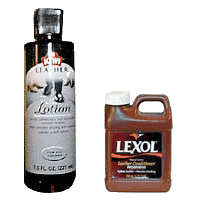 The blade is not the only component of the sword that requires maintenance. The grip and furniture should receive their fair amount of attention as well. When rust or tarnish is encountered a quick rubbing with the aforementioned polishing compound and steel wool is usually sufficient. This exercise, when coupled with oiling, should keep the hilt components free of rust.
The blade is not the only component of the sword that requires maintenance. The grip and furniture should receive their fair amount of attention as well. When rust or tarnish is encountered a quick rubbing with the aforementioned polishing compound and steel wool is usually sufficient. This exercise, when coupled with oiling, should keep the hilt components free of rust.The sword's grip can be cared for in a number of ways. Most leather grips have been covered with leather that has been shrunk to fit with beeswax or something similar. The resulting covering is tight a free of give. Products such as Neat's-foot oil may be used. If chosen they should, however, be used sparingly so as not to loosen the fit of the leather. Products such as Saddle Soap or Kiwi Leather Lotion are much preferred to oil based preservatives. These will not loosen the leather over time and will provide protection from the elements. When it gets down to it a leather grip covering requires little maintenance. If it starts to look shabby and worn then it should receive attention, otherwise it is best left alone. A wire grip really requires nothing more than an occasional buffing with steel wool to keep it looking good. Grips of Bone or Ivory should be left alone. If cleaning is required an application of lemon juice should be sufficient to whiten the surface. Wooden grips, if made from stabilized woods require little maintenance. Many lower end swords are made with different types of woods such as Philippine and Indian ebony that have not been fully stabilized or cured. Grips like these should be treated with boiled linseed oil regularly to prevent them from splitting or cracking. Restoration Example Careful application of the techniques described in this article can even restore badly patinated pieces to like-new condition: 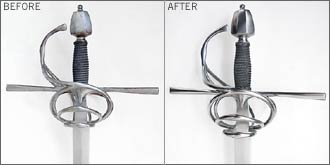
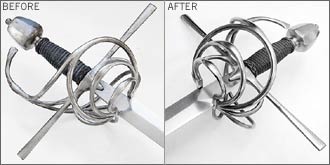
Click above photos to enlarge.
Conclusion As I previously stated, none of these methods are particularly complicated or time-consuming. If properly followed, they will keep your cherished replica looking good, and well maintained, for years to come. About the Author Patrick is a State Trooper serving with the Kansas Highway Patrol. He has been fascinated with edged weapons, particularly the medieval sword, since early childhood. Not only is Patrick thankful for any opportunity to indulge in his favorite hobby, he is also blessed with a wife who tolerates a house full of sharp pointy things. |
|